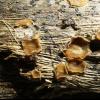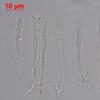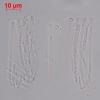
17-01-2026 19:35
Arnold BüschlenHallo, ich suche zu Cosmospora aurantiicola Lite

15-01-2026 15:55
 Lothar Krieglsteiner
Lothar Krieglsteiner
this one is especially interesting for me because

16-01-2026 00:45
Ethan CrensonHi all, On decorticated hardwood from a New York

18-01-2026 12:24
Hello.An anamorph located on the surface of a thin

08-12-2025 17:37
 Lothar Krieglsteiner
Lothar Krieglsteiner
20.6.25, on branch of Abies infected and thickened

10-01-2026 20:00
Tom SchrierHi all,We found picnidia on Protoparmeliopsis mur

13-01-2026 07:28
 Danny Newman
Danny Newman
Chlorociboria glauca on indet. decorticate logThe
Orbilia from Kenya
Ibai Olariaga Ibarguren,
13-10-2013 10:38
Hi!
This is a second species found together with the Hydropisphaeria, in a herbarium specimen from Kenya on Lobelia (or maybe an Euphorbiaceae). It is orbilioid.
Apothecia up to 4 mm when dry, 300-400 µm thick in section, cup-shaped, yellowish brown. Ascospores filiform, curved, 11-17 x 0.8-1.2 µm. Asci probably 8-spored, 37-45 x 3-4 µm, forked at the base. Paraphyses claviform-capitate at the apex, 2.5-3.5 µm, with a crystalline yellowish matter on top of them. Medulllary excipulum of t. globosa. Marginal hairs strongly glossy, with a slightly rough surface at x1000, 4.5-6 µm broad. Abundant anchoring hyphae seen at the base. Conidia not seen.
Any clue?
Thanks in advance, Ibai.
Hans-Otto Baral,
13-10-2013 11:08

Re : Orbilia from Kenya
Good collection, though regrettably not fresh.
Clearly a member of Auricolores, but the group is difficult to estimate. A possible relation would be Orbilia menageshae which we are going to describe from Aethiopia. It grew on unidentified angiosperm bark but also on herbaceous stem of Solanecio, in a forest with Lobelia giberroa and Solanecio gigas.
The glassy processes were only 2-4 µm long but on the herbaceous stem 8-30 µm. The spores measured 12–14.5(–15.5) × 1–1.3 µm when dead (shorter when alive because stronger curved).
We have a sequence of O. menageshae, and the anamorph which forms adhesive nets like O. auricolor. But the conidia are formed singly at the tip of the long conidiophores.
Zotto
Clearly a member of Auricolores, but the group is difficult to estimate. A possible relation would be Orbilia menageshae which we are going to describe from Aethiopia. It grew on unidentified angiosperm bark but also on herbaceous stem of Solanecio, in a forest with Lobelia giberroa and Solanecio gigas.
The glassy processes were only 2-4 µm long but on the herbaceous stem 8-30 µm. The spores measured 12–14.5(–15.5) × 1–1.3 µm when dead (shorter when alive because stronger curved).
We have a sequence of O. menageshae, and the anamorph which forms adhesive nets like O. auricolor. But the conidia are formed singly at the tip of the long conidiophores.
Zotto
Ibai Olariaga Ibarguren,
13-10-2013 14:44
Re : Orbilia from Kenya
Thanks for your interesting answer Zotto!
The ecology you mention for O. menageshae might be similar to that of this collection. It was collected in the "upland forest between Nairobi and Kenya".
I wonder if it would be of any help if I tried to find the anamorph. Should I look for it on the substrate surface around the apothecia?
Cheers,
Ibai.
Hans-Otto Baral,
13-10-2013 17:49

Re : Orbilia from Kenya
I actually did not see it on the substrate, only in culture. The conidia are ca. 30-50 x 14-18 µm, so should easily be seen. Sometimes conidia are seen when mounting an apothecium, but the you do not know whether they aere formed in fascicles or singly.








